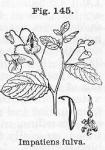 The plants Impatiens pallida, Nuttall, and Impatiens fulva, Nuttall.
The plants Impatiens pallida, Nuttall, and Impatiens fulva, Nuttall.
Nat. Ord.—Geraniaceae.
COMMON NAMES: I. (Impatiens pallida), Balsam jewelweed, Balsam weed, Pale touch-me-not. II. (Impatiens fulva), Speckled jewels, Spotted touch-me-not.
Botanical Source.—Impatiens pallida is an indigenous annual plant having a smooth, succulent, tender, subpellucid, branching stem, with tumid joints, growing from 2 to 4 feet in height. The leaves are oblong-ovate, coarsely and obtusely serrate, teeth mucronate, from 2 to 5 inches long, petiolate, and about two-thirds as wide. The flowers are large, pale yellow, sparingly maculate, and mostly in pairs; the peduncles, 2 to 4-flowered and elongated. The sepals are apparently but 4, the 2 upper united, the lowest gibbous, dilated-conical, broader than long, with a very short, recurved spur. The petals are apparently 2, unequal-sided and 2-lobed, each consisting of a pair united. Stamens 5, short; anthers opening on the inner face, connivent over the stigma. Ovary 5-celled; stigma sessile. Capsules oblong-cylindric, an inch long, 5-valved, bursting at the slightest touch when ripe, and scattering the anatropous seeds (W.—G.).
 Impatiens fulva is the most common variety; its leaves are rhombic-ovate, obtusish, coarsely and obtusely serrate, with teeth mucronate. The flowers are smaller than in the previous one, deep-orange, maculate, with many brown spots; lower gibbous sepals acutely conical, longer than broad, with an elongated, recurved spur.
Impatiens fulva is the most common variety; its leaves are rhombic-ovate, obtusish, coarsely and obtusely serrate, with teeth mucronate. The flowers are smaller than in the previous one, deep-orange, maculate, with many brown spots; lower gibbous sepals acutely conical, longer than broad, with an elongated, recurved spur.
 Impatiens balsamina, the Garden balsam, or Ladies' slippers, is spontaneous about gardens; its leaves are lanceolate, serrate, upper ones alternate; peduncles clustered and 1-flowered; spur shorter than the flowers. The flowers are red, white, purple, pink, flesh-color, and scarlet; sometimes they are double. This is an exotic plant, a native of the East Indies, and cultivated as a beautiful garden annual. Its height is from 1 to 5 feet (W.—G.).
Impatiens balsamina, the Garden balsam, or Ladies' slippers, is spontaneous about gardens; its leaves are lanceolate, serrate, upper ones alternate; peduncles clustered and 1-flowered; spur shorter than the flowers. The flowers are red, white, purple, pink, flesh-color, and scarlet; sometimes they are double. This is an exotic plant, a native of the East Indies, and cultivated as a beautiful garden annual. Its height is from 1 to 5 feet (W.—G.).
History.—These plants grow throughout the United States, in moist, shady places, and along rills, in rich soil, flowering from July to September. The I. pallida is most common northward and westward, and the I. fulva southward. Both plants possess similar properties. The leaves are astringent. The whole plants are used medicinally, and impart their virtues to water. They contain a yellow coloring matter, but have not been chemically studied.
Action, Medical Uses, and Dosage.—They are aperient and diuretic; a decoction is recommended in jaundice, hepatitis, and dropsy. The juice is said to remove warts, cure ringworms, salt-rheum, etc., and to cleanse foul ulcers; or it may be applied for these purposes in the form of a poultice boiled in milk. The bruised plants or the juice applied to parts poisoned by rhus, give prompt relief. It also gives relief from the effects of stinging nettle. The recent plant boiled in lard, forms an excellent ointment for piles.

